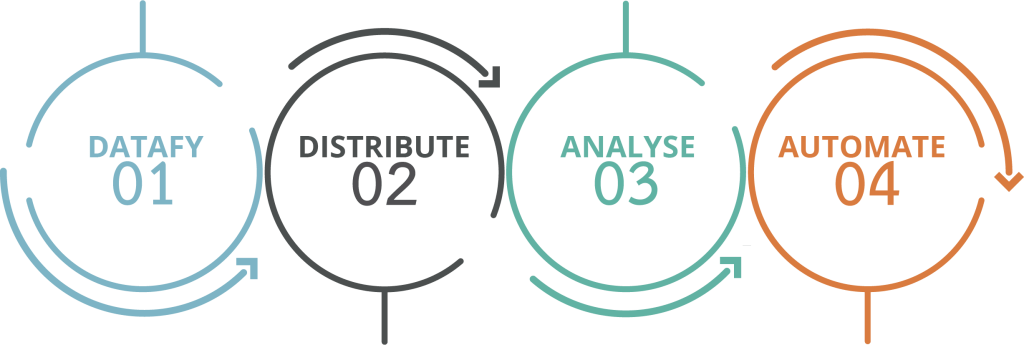4 Steps to be Successful with the Digital Transformation of Your Business

According to McKinsey, data-driven organisations are 23x more likely to acquire customers, 6x more likely to retain customers and 19x more likely to be profitable. Being data-driven is good for business. Therefore, it is not a surprise that one question I always get when advising organisations is how to digitally transform your business and remain relevant in these fast-changing times.
My first answer is to tell them that they have to achieve a gestalt shift, where they see their organisation from a different perspective. Instead of looking at your organisation from a product standpoint, you should see your organisation as a data organisation. This shift in perspective will fundamentally change how you run your organisation, as all of a sudden it opens new doors.
If your organisation wants to succeed in becoming a data organisation, the first step is having infinite streams of complete, high-quality, well-cleansed, unbiased data that is collected at every process and customer touchpoint within your organisation. The second step of transforming your organisation into a data organisation is to distribute that data, thereby facilitating new ways of collaboration with industry partners using distributed ledger technologies and making the data available to all your employees regardless of their location using public/private/hybrid cloud solutions. Not all problems require a blockchain solution, but to enable seamless collaboration, data needs to be available in the cloud.
Once company-owned data has been made easily accessible and exchangeable with internal and external stakeholders, it allows for more efficiency, transparency, security and privacy across every step in the value chain. Of course, in the near future, this will require a different approach as within the next decade, ownership of data will be returned to consumers.
The third step in digitally transforming your business is to analyse the available data for insights, patterns and anomalies using descriptive, predictive, and prescriptive analytics. This will provide you with insights into your environment and the context to improve your decision-making. The final step will be to automate your internal processes and your decision-making. Smart algorithms will enable automation, but it is key that you have developed the right governance practices to ensure responsible AI. This leads us to the secret sauce to the digital transformation of your organisation:

Figure 1: The D2 + A2 model
This D2 + A2 model consists of several actions, stakeholders and required technologies that will help you prepare your organisation for tomorrow. Let’s discuss each step in the D2 + A2 model to explain why it is important, how you can approach it and what technologies will enable it:
1. Datafy your Processes
Digitally transforming your organisation requires data above all. To achieve that, the first step is to datafy your organisation. Datafication is the process of making a business data-driven, by transforming social action into quantified data. It involves collecting (new) data from various sources and processes using IoT devices or creating detailed customer profiles. Datafying your organisation starts by making your office, your workplace, your processes and your products smart. It will make previously ‘invisible’ processes traceable so that they can be monitored, analysed and optimised.
Thanks to the lowering costs of sensors, increasing low-cost bandwidth, cheap availability of cloud-computing and processing capacity as well as numerous connected devices it has become easier and cheaper to make these processes smart. It will enable you to capture data consistently and universally across different processes, products and workplaces.
Next to previously offline customer touchpoints, of course, you can also collect data at the online customer touchpoints, such as social media interactions. The data can then be used to create insights using analytics or enable actions using smart contracts. Of course, data quality is of the utmost importance when datafying your organisation. Low-quality and biased data will be useless and can even cause damage to your organisation and customers. The datafication of your organisations opens a whole new line of possibilities, which you should approach from an out-of-the-box perspective. Only then will you be able to come up with a real added value for your organisation.
There is hardly any limit to the datafication of your processes and your workplaces, as long as you comply with regulations that protect your employees and customers. However, the datafication of personality using websites and applications is a lot more difficult. Increased attention to privacy and security and regulations such as the GDPR make storing sensitive customer data increasingly harder.
Therefore, the first step that you can take is to identify those processes within your organisation that you want to improve. While evaluating the processes, investigate what you need to do to collect data from those processes. Do you need to install sensors to monitor activities or do you need to collect more data to create detailed customer profiles? Once you have identified the required technologies, start collecting the data.
When you start datafying your organisation, the idea would be to start small, with simple processes that are relatively easy to datafy. Once you have gained experience with datafying your processes, you can focus on more complex processes.
The datafication of your organisation is the first step in digitally transforming your business. The stakeholders within this process are your employees, customers and the business processes available within your organisation and supply chain. The technology required for this is smart sensors and IoT devices that will be used to streamline and improve existing business processes. The result will be a significant change in culture. Not only will employees behave differently if they are aware that their behaviour is monitored on the workplace, but it will also make their work easier as they have more data at hand.
2. Distribute your Data
Once you are collecting data within every process and customer touchpoint, it is, of course, important to store that data in order to use it. There are two ways of doing so. When digitally transforming your organisation, you will, ideally, use a combination of these two technologies. First of all, you can distribute the data using distributed ledger technologies such as blockchain. It is important to note that distributed ledgers are not distributed to distribute data but to make the system resilient. The key is making data with high integrity accessible to multiple stakeholders. As such, the key to using blockchain is integrity and to create trust and transparency across (geographically) dispersed stakeholders.
Although blockchain can be beneficial to all industries, it does not mean that every problem requires a decentralised solution. A decentralised solution is only required when there is a trust issue (which generally happens when individuals, organisations and things want to collaborate across organisational borders or between individuals) and when a transaction is taking place. In other occasions, distributed ledger technology is not the required technology. In that case, you are better of using cloud computing technology. Depending on your requirements, you can use a private, public or hybrid cloud solution.
The cloud can be especially useful to store, analyse, visualise and share data within an organisation, where it does not matter that there is a centralised database. Naturally, this would be the case for transactions being done within one organisation and without external stakeholders being involved.
Distributing your data, whether centralised or decentralised, has multiple benefits for your organisation and three of the most important benefits are:
- Security: decentralised solutions are highly secure as we have seen in Chapter 5. In addition, cloud computing is generally more secure than on-premises data storage since data storage is not a core business process of most organisations.
- Quality control: Decentralised solutions require extreme data governance processes to ensure that only high-quality data is stored on a blockchain, while cloud computing allows you to store a single version of your data centralised, instead of in silos. Hence, distributed data is likely to be high-quality data, although this does not happen automatically, of course.
- Cost-saving: a centralised database in the cloud that is used by the entire organisation is cheaper than separate silos that cannot interact. In addition, although a decentralised solution seems more expensive (since everyone needs to store a copy of a blockchain), the benefits of, for example, instant settlement of transactions easily offset these extra costs.
Distributing your data, whether using a decentralised solution or using cloud computing, enables industry collaboration. To start with distributing your data, make sure you remove existing data silos within the organisation. Data silos are barriers to optimal usage of your data. In addition, similar to datafying your first process, start with a small proof of concept when distributing your data. For example, if you are a retailer, look at one single product and understand the processes it takes to incorporate blockchain technology to create peer-to-peer collaborating with the various industry partners.
The result will be increased collaboration. Not only among internal stakeholders and business units who can work with a single source of data, but also by enabling secure and trustworthy collaboration among industry partners. It becomes possible to share proprietary data with your competitors, benefiting both without revealing any company secrets.
3. Analyse for Insights
After collecting data in every company process and customer touchpoint and storing the data in a distributed way, it is time to analyse that data using advanced analytics. For many businesses, the most likely path to creating competitive advantage is already by using this ‘big data’ and subjecting it to (advanced) analytics such as descriptive, diagnostic, predictive or prescriptive analytics. It has become a pre-requisite for a company facing uncertainty to use analytics to understand the environment and better grasp the context of their organisation.
Therefore, if you want to digitally transform your organisation, you cannot do without comprehensive analytics. It is required to understand what is going on and how to respond to changes in the context of the organisation. However, where data become increasingly important, and knowledge is shared within the company, data shift the power structure within the business; moving it away from leaders with years of experience to those employees who have access to data and the power to analyse that data for insights to make (strategic) decisions and create new opportunities.
Traditionally, decisions are made by those managers and leaders within the organisation that have the most experience and have access to the right information. Important information used to be provided solely to those decision-makers. As such, they were more knowledgeable than the rest of the organisation. However, the introduction of big data analytics changed this. Once a data-driven, information-centric culture is implemented, data and insights from data become widely accessible, in real-time and across the organisation.
The more data you have, the better the models will become that you can create using various data mining techniques, resulting in more business value for your organisation. As such, your decision-makers will be the stakeholders who are involved in the process of analytics. Especially, when more members of your organisation have access to these insights, empowerment is a possibility resulting in a shift in power and culture.
Consequently, in data-driven businesses, the real decision-makers within an organisation are not senior managers or C-level executives but are those employees that face the customer or who are directly involved in creating the product or service. Some leaders might be reluctant to accept this shift in power, but only when your culture changes, can you truly benefit from big data analytics. Within the organisation of tomorrow, anyone with access to insights from data should be able to make a decision, resulting in flatter organisations.
4. Automate your Organisation
The final step in digitally transforming your organisation is to automate your business processes and augment your customer touchpoints with artificial intelligence or smart contracts. Artificial intelligence will become especially valuable if you have completed the first three steps. Artificial intelligence requires large amounts of high-quality and unbiased data. Exactly what your organisation will have after datafying the different business processes and distributing the data using DLT or the cloud.
In addition, thanks to data provenance when applying distributed ledger technology, it becomes possible to understand better why an algorithm came to a certain decision as it offers a traceable overview of the collected and used data, thereby contributing to achieving explainable AI. The end goal of the transformation process is to develop responsible unbiased AI that becomes increasingly advanced, resulting in increased productivity and efficiency.
Once you have successfully automated certain processes, it will directly affect the future of work in your business. We can expect a shift in how we work. Work will move away from full-time work and move to a lot more contract-based, flexible work, with a focus on output instead of input. This will significantly change the organisation and requires adaptation by governments to enable organisations to hire more flex-workers without the requirement to offer employees fixed contracts.
In the coming years, AI will be more used to augment workers than to replace your employees. Consequently, the increasing convergence of humans and machines will result in social, technological, political and ethical implications, where artificial intelligence and humans are becoming increasingly interwoven in mutually dependent networks. Within these human-machine networks, both artificial and non-artificial agents interact in the same context, and that will significantly transform existing organisations. It will require organisations to offer lifelong learning for their employees, and in return, it will require flexibility and adaptation of those employees. When executed correctly, it will make your organisation more humane.
Final Thoughts
Together, the above four steps make up the D2 + A2 model, as shown in figure 1. Summarising, to digitally transform your organisation, you should datafy your processes and customer touchpoints, ensuring high-quality data and the right data governance practices are in place. The introduction of sensors and IoT devices will result in a change in your company culture as employees and customers will need to get used to the datafication of these processes.
Once collected, the data can then be distributed either using distributed ledger technologies such as blockchain to enable trustless transactions and collaboration among industry partners. As such, blockchain will be the golden standard for supply chains. For internal use, you should move to the cloud to enable your employees to have access to one single version of data across the organisation.
The third step is to analyse that data and using various data mining techniques to discover patterns across various data sources and obtain a better understanding of the context of the organisation. Descriptive analytics will enable the organisation to better sense the changes in your changing environment, while predictive analytics will help you seize the opportunities sensed by improving your decision-making capabilities. The organisation of tomorrow will also apply prescriptive analytics to transform your tangible and intangible assets accordingly.
Finally, the organisation of tomorrow uses artificially intelligent agents such as immutable smart and (hopefully unbiased) algorithms to automate your business processes and augment your customer touchpoints, resulting in a more efficient and effective organisation. The result of following the four steps of Datafying, Distributing, Analysing and Automating is sustained competitive advantage. It will turn your organisation into a data organisation that is ready for the data-driven future ahead of us.
This is an excerpt from my latest book: The Organisation of Tomorrow, which is available on Amazon, Book Depository, Barnes & Noble or via my publisher Routledge.
Image: Chan2545/Shutterstock





